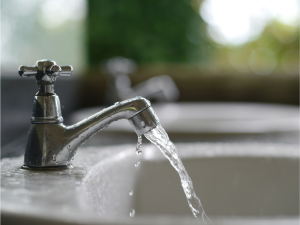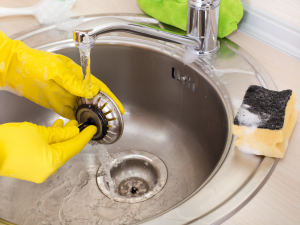When it comes to odd stains and marks around your faucets and sinks, few are worse than calcium deposits.
Also known as limescale, these deposits can show up on any surface, not just your faucets. They’re often quite stubborn and hard to deal with, often causing many homeowners to want to learn how to clean calcium buildup from their faucets and other surfaces.
As with many techniques for cleaning your bathroom or kitchen, there are lots of different ways you can do that. While using commercial cleaners is one great way, many homeowners are more concerned with the state of their plumbing while others prefer more environmentally friendly alternatives. In this article, we’ve made sure to give both possible options for effective cleaning and eco-conscious options.
And if you find that the deposits are somewhere out of your reach while removing calcium buildups, or if you need professional help installing new systems, our team at Clover Contracting is ready to help whenever you need it.
What Causes Calcium Buildup?
When considering what causes these problems and how you can go about doing a calcium buildup removal, the first place you should look into is the water itself.
More often than not, these buildups are caused by hard water. Hard water often contains high amounts of minerals, and calcium is one of the most common minerals found in it.
Over longer periods of time, hard water and the minerals in your water can cause stains and, as you’ve noticed – deposits. Calcium deposits are often one of the most problems that many homeowners face with their hard water supply, only really second to the orangish magnesium stains.
However, if these deposits and stains form faster than anticipated, you might have hard water with unsafe amounts of minerals.
If that’s the case, the best – and, frankly, only – solution is to invest in a water softener.
How to Clean Calcium Buildup Around Your Sinks
One of the most likely places that you might find calcium buildup is around the sinks and faucets in your home. This is primarily because water finds its way to the base of the faucet and even to the edges. When dealing with hard water, the minerals are typically left behind when the water evaporates, indirectly leading to the mineral deposits worsening the longer you avoid cleaning them up.
Using Limes and Lemons
One way on how to clean calcium buildup is by using citric fruits, particularly limes and lemons. These fruits have higher levels of citric acid in them, and when mixed with the lime or lemon’s juices, allow the acid to soak into the dried limescale. The acid itself acts as a great cleaner that’s effective in cleaning while also being gentle on your faucet and the surfaces around the sink.
Much like with other methods of cleaning things around your home that also use lemons and limes, you only need one wedge. Simply rub it against the surface of the limescale, letting the juices soak in for a few seconds before scrubbing at it. Repeat the process until the limescale is gone, then rinse the faucet and sink with water before drying it.
Clean With a Vinegar Soaked Cloth
Much like lemon and limes, vinegar is another great option for an effective cleaner that you may just have in your home. Vinegar is often used to clean all sorts of surfaces, both indoors and outdoors, making it useful for many situations. As an acid itself, vinegar has much of the same dissolving power that citric acid does, though many sources claim vinegar is far stronger.
When cleaning your faucet with vinegar, it’s ideal that you use a towel to soak some up first. Though you can also fill a small storage bag with vinegar and put parts of your faucet into it, the towel allows you to cover the entire faucet with ease. Let the vinegar soak into the deposits for an hour before scrubbing them. When you’re done, wipe down the faucet and the surrounding areas.
Dealing With Calcium Buildup in Toilets and the Rest of Your Bathroom
Unfortunately, just like your faucets and sinks, the toilets in your bathroom are just as prone to calcium deposits. If your house has access to hard water, the calcium can form layers on the edges of the water line inside the bowl and tank. Every time you flush, the water drains away, but more hard water replaces it and deposits more calcium. Eventually, the limescale becomes clear to see.
How to clean calcium buildup in toilet bowls is much the same as cleaning a sink or faucet, though with a few added steps due to the water in the tank and bowl.
To start, turn the water supply to the toilet off and flush to get rid of the water inside. With the deposits exposed, spray them with a bit of vinegar before letting it sit for half an hour. Then, simply scrub at the deposits with a toilet brush. Once the deposits are gone, you can turn the water back on.
Baking soda is also a good option to help the cleaning process. Like vinegar, baking soda is a commonly used ingredient for more gentle cleaners. If you want to use baking soda instead, repeat the process above, but sprinkle some of the soda onto the toilet brush. Instead of waiting beforehand, just use the brush to scrub at the deposits.
The last way to clean up calcium buildup in toilets is by using a pumice stone. Since this requires more manual work than the other methods, you’ll need to protect your hands with rubber gloves.
Takeaway
When it comes to dealing with calcium buildups, there are many different ways that you can clean them off. Vinegar and baking soda (separately) are great options that are both effective and gentle on your faucets and toilets. However, commercial cleaners work just as well.
Ultimately, the best solution is prevention. Installing a water softener into your home with our team ensures that the calcium deposits formed as a result of your hard water supply are drastically reduced. And, on top of that, your home will feel much nicer to live in.








